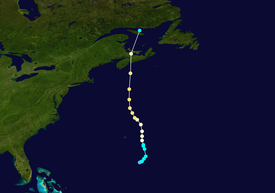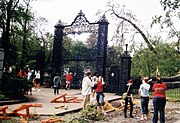| Revision as of 14:21, 10 September 2006 edit24.222.211.154 (talk) →Preparations← Previous edit | Revision as of 02:21, 21 September 2006 edit undoThegreatdr (talk | contribs)Autopatrolled, Extended confirmed users, Pending changes reviewers, Rollbackers43,166 edits →ImpactNext edit → | ||
| Line 36: | Line 36: | ||
| ==Impact== | ==Impact== | ||
| ] | |||
| Juan caused widespread damage in central ] and ]. Hurricane Juan's maximum sustained wind speed at landfall in Nova Scotia was measured at 100 mph (160 km/h). The majority of severe property damage was concentrated in the western urban core of the ]. Less severe property damage was recorded west of the storm's track into ] and ]. In addition to Halifax Regional Municipality's urban core, the town of ] and city of ] were urban areas which also experienced significant property damage. | Juan caused widespread damage in central ] and ]. Hurricane Juan's maximum sustained wind speed at landfall in Nova Scotia was measured at 100 mph (160 km/h). The majority of severe property damage was concentrated in the western urban core of the ]. Less severe property damage was recorded west of the storm's track into ] and ]. In addition to Halifax Regional Municipality's urban core, the town of ] and city of ] were urban areas which also experienced significant property damage. | ||
Revision as of 02:21, 21 September 2006
- This article is about the 2003 hurricane; there was also a Hurricane Juan during the 1985 Atlantic hurricane season.
| hurricane | |
|---|---|
| Formed | September 24, 2003 |
| Dissipated | September 29, 2003 |
Hurricane Juan was the tenth named storm and the sixth hurricane of the 2003 Atlantic hurricane season. It was a category two hurricane that struck the Canadian provinces of Nova Scotia and Prince Edward Island, causing significant damage to trees and property, particularly within the urban core of the Halifax Regional Municipality. The storm killed 8 and caused over $200 million in damages. It was likely the region's most powerful hurricane since the Hurricane of 1873.
Storm history

Map key Saffir–Simpson scale Tropical depression (≤38 mph, ≤62 km/h)
Tropical storm (39–73 mph, 63–118 km/h)
Category 1 (74–95 mph, 119–153 km/h)
Category 2 (96–110 mph, 154–177 km/h)
Category 3 (111–129 mph, 178–208 km/h)
Category 4 (130–156 mph, 209–251 km/h)
Category 5 (≥157 mph, ≥252 km/h)
Unknown Storm type
 Tropical cyclone
Tropical cyclone  Subtropical cyclone
Subtropical cyclone  Extratropical cyclone, remnant low, tropical disturbance, or monsoon depression
Extratropical cyclone, remnant low, tropical disturbance, or monsoon depression The tropical depression that would be Juan formed on September 24, 2003 northeast of the Bahamas. On Thursday September 25, the depression began to organize and turned northwest. On September 25, the depression intensified into Tropical Storm Juan. At this time the storm was crossing the waters of the Gulf Stream, which were unusually warm for this time of year in this part of the northwest Atlantic. On September 26, Juan was classified as a Category 1 hurricane on the Saffir-Simpson hurricane scale and the storm's track was wavering slightly to the northeast.
On September 27, Juan changed course and came under increasing influence of the northerly flowing jetstream, with a projected track now placing it on course for landfall in central Nova Scotia. On September 27, Juan's reached a peak windspeed of 105mph and the storm was reclassified as a stronger category 2 hurricane. The storm maintained this intensity through September 28 and moved directly north toward the western urban core of the Halifax Regional Municipality.

It struck Prospect, Nova Scotia, 20 miles (30 km) southwest of Halifax Harbour on Monday September 29, with 100 mph winds.
Upon making landfall on the central Atlantic coast of Nova Scotia, the storm continued to move to the north extremely rapidly, crossing the Nova Scotia peninsula and Prince Edward Island within hours, downgrading to a strong category 1 hurricane. By mid-day the storm was centred over the Gulf of St. Lawrence and downgraded to a tropical storm before becoming extratropical over the eastern part of Labrador.
Preparations
On September 27, as Juan approached, warning broadcasts on local media in Atlantic Canada were changed accordingly and the public and emergency officials in the expected landfall area were told to make preparations for a potential disaster.
As Juan loomed off-shore as a category two, media warnings continued, largely unheeded by the general public, many of whom were not taking the threat seriously, or were not listening to broadcast media over the weekend.
On Sunday morning, September 27th the latest reports indicated that Juan would make landfall either as a tropical storm or marginal category one hurricane. Weather broadcasts up to that time gave every indication that the storm would weaken prior to landfall. By 6 p.m. hurricane warnings were issued, as Juan was expected to make landfall as a strong category 1 or weak category 2 hurricane. At this point it was too late for much of the general public to make necessary preparations.
Impact
Rainfall across southeast Canada from Juan Juan caused widespread damage in central Nova Scotia and Prince Edward Island. Hurricane Juan's maximum sustained wind speed at landfall in Nova Scotia was measured at 100 mph (160 km/h). The majority of severe property damage was concentrated in the western urban core of the Halifax Regional Municipality. Less severe property damage was recorded west of the storm's track into St. Margaret's Bay and Mahone Bay. In addition to Halifax Regional Municipality's urban core, the town of Truro and city of Charlottetown were urban areas which also experienced significant property damage.
The urban concentration surrounding Halifax Harbour bore the brunt of the highest sustained winds and strongest wind gusts during the storm; some unofficial estimates have placed gusts as high as 145 mph (230 km/h). Wave-rider weather buoys off the entrance of Halifax Harbour snapped their moorings after reportedly recording waves in excess of 20 metres (65 ft). Significant erosion occurred on the populated shores of the harbour, particularly in the Bedford Basin where residential properties and railway tracks got most of the wave action. The severity of property damage in the urban core of Halifax Regional Municipality initially led some forecasters to believe that Juan was likely a Category 3 hurricane, however the sustained wind reports did not justify that suggestion. Many of the deciduous trees in central Nova Scotia still had leaves, which magnified the effects of wind damage.

Juan left more than 300,000 people without power in both Nova Scotia and Prince Edward Island. It took up to a week and a half to restore power to the hardest hit rural areas of Nova Scotia's Eastern Shore and the Musquodoboit River valley. Voting in the PEI general election on September 29, 2003 was also disrupted but more than 80% of voters made it to polling stations.
70% of the trees in Halifax's Point Pleasant Park were destroyed, fundamentally changing the character of the large urban park. The Halifax Public Gardens was also badly damaged. Charlottetown's waterfront sustained heavy wave damage to pleasure craft and sea walls, as well as significant damage to the older urban forest in that city's downtown core.
Juan claimed 2 lives directly and 6 indirectly in Nova Scotia and Quebec, although those lost in the latter province were actually fishermen from New Brunswick operating near Anticosti Island.
Aftermath

Hurricane Juan alerted residents, governments, utilities, and emergency management agencies throughout Atlantic Canada to improve preparations for devastating events such as hurricanes. Especially with climatological data pointing to possible increased frequency of major ocean storms and extratropical cyclones.

(2003 was an eventful year for hurricanes impacting Canada. In addition to Juan, three other storms—Fabian, Isabel and Kate—had a significant effect on land or offshore.)
Preparations and planning have been underway since 2003 and were tested most recently when Hurricane Ophelia was forecast to brush near Nova Scotia in early September 2005. Hurricane Juan has also resulted in several changes to the Meteorological Service of Canada's Canadian Hurricane Centre, which has relocated from a vulnerable and exposed office building in Dartmouth, Nova Scotia to a more secure location that can withstand hurricane damage. CHC's hurricane warning system has also been improved; traditionally, CHC did not issue standard hurricane or tropical storm watches or warnings (just high wind and heavy rainfall warnings), which were not heeded by local residents. Beginning in the 2004 Atlantic hurricane season, CHC began using standard hurricane warnings for storms potentially affecting Canada.
Retirement
See also: List of retired Atlantic hurricanesBecause of its effects in Canada, the name Juan was retired in April 2004 and will never again be used for an Atlantic hurricane. It was the first time that the Meteorological Service of Canada had specifically requested a hurricane name be retired; most hurricanes which have affected Canada in the past had previously caused damage elsewhere, usually along the US East Coast. The name was replaced by Joaquin for the Template:Tcseason.
References
- http://www.novaweather.net/Hurricane_Juan_files/Juan_Summary.pdf
- http://www.atl.ec.gc.ca/weather/hurricane/juan/track2_e.gif
See also
- List of notable tropical cyclones
- List of notable Atlantic hurricanes
- List of retired Atlantic hurricanes
External links
- National Hurricane Center Tropical Cyclone Report – Hurricane Juan
- Environment Canada's Juan Information Page
- CTV Hurricane Juan retrospective story
- The Hurricane Hut – Comprehensive Summary of Hurricane Juan
- Novaweather Storm Page – Chris Fogarty's study of the storm
| Tropical cyclones of the 2003 Atlantic hurricane season | ||
|---|---|---|
 | TSAna TDTwo TSBill 1Claudette 1Danny TDSix TDSeven 1Erika TDNine 4Fabian TSGrace TSHenri 5Isabel TDFourteen 2Juan 3Kate TSLarry TSMindy TSNicholas TSOdette TSPeter | |